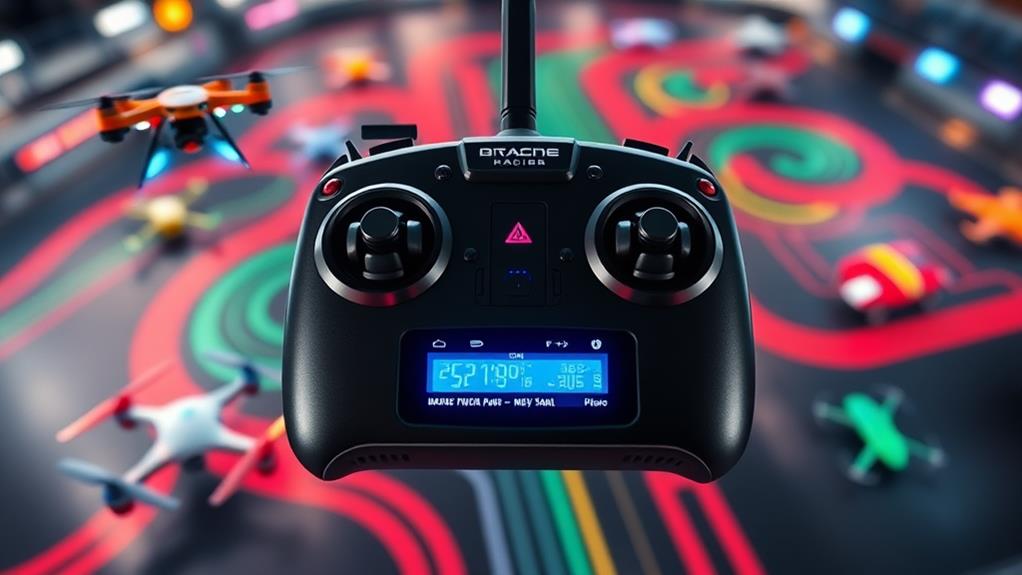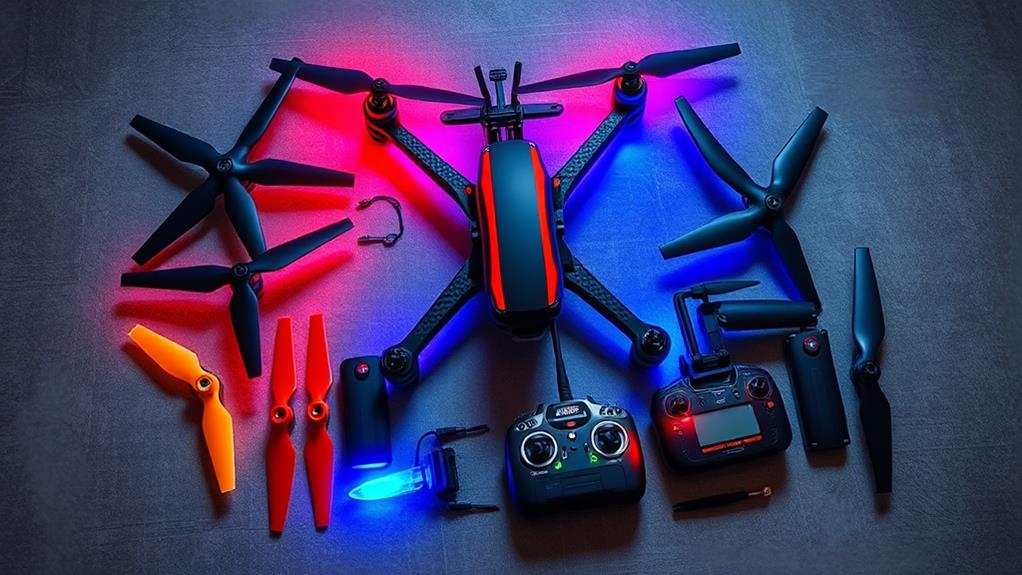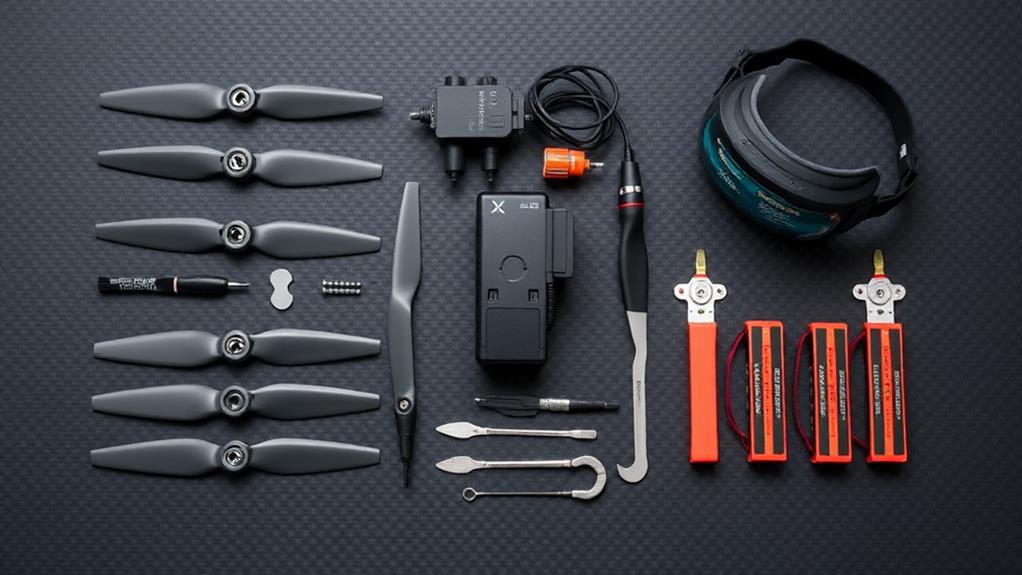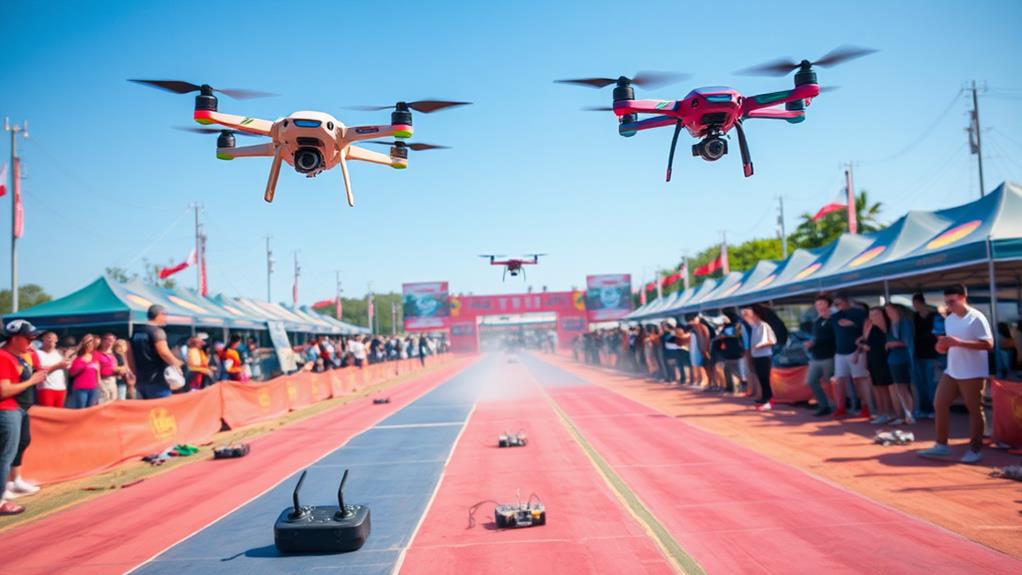To achieve success in drone racing, you'll want to invest in essential gear. Start with a reliable transmitter like the FrSky Taranis QX7, known for its range and versatility. Pair this with high-quality FPV goggles, such as the Fatshark Dominator HDO, which offer excellent video resolution and comfort. Don't overlook key hardware components, ensuring your flight controller and ESCs provide top performance. Choose the right battery, preferably a 6S configuration, for ideal speed. Also, gather important tools, like a portable soldering iron, to handle repairs quickly. With this gear, you'll be well-equipped, and there's more to explore about enhancing your racing experience.
Essential Transmitters for Racing

When it comes to drone racing, having the right transmitter can make all the difference. A quality transmitter not only enhances your control but also guarantees seamless communication with your FPV goggles, which is vital for maintaining agility and speed during races.
The FrSky Taranis QX7 stands out as a popular choice among professional racers, thanks to its versatility and long-range capabilities, typically priced around $200. If you're looking for a budget-friendly option, the Jumper T16 offers multi-protocol compatibility and built-in charging for about $110, making it an excellent upgrade without breaking the bank.
For those serious about long-range racing, consider adding the TBS Crossfire LITE module to your setup. At just $50, it boosts your control range considerably, providing reliable communication during intense races.
If you're after compactness, the TBS Tango 2 Pro features a built-in Crossfire, appealing to pilots who value portability alongside performance.
Don't overlook ergonomics when choosing your transmitter; comfort is essential for maintaining control during prolonged sessions. Models like the Radiomaster TX16S and Jumper T16 prioritize user-friendly designs, guaranteeing you stay focused on your race.
Keeping in mind the importance of transmitter features will enhance your overall racing experience and performance.
High-Quality FPV Goggles
When it comes to drone racing, high-quality FPV goggles play an essential role in your overall experience.
You'll want to prioritize comfort and video quality, as these factors directly impact your performance during long races.
Additionally, ensuring your goggles are compatible with various equipment can make a significant difference in your setup and flying style.
Importance of Comfort
Comfort plays an essential role in drone racing, especially when it comes to high-quality FPV goggles. When you're racing for extended periods, having the right comfort features can make all the difference. High-quality FPV goggles prioritize ergonomic design, ensuring they fit snugly and securely without causing discomfort during those intense races.
The ability to execute advanced maneuvers, such as the Power Loop, requires undistracted focus, which comfort directly supports.
- Adjustable foam padding for a custom fit
- Flexible head straps that accommodate various head sizes
- Lightweight materials to reduce fatigue
These comfort features are vital for accommodating different face shapes, allowing you to focus on racing rather than adjusting your gear constantly.
Premium FPV goggles, like the Fatshark Dominator HDO and Orqa FPV.one, excel in providing a balance between comfort and performance. Their ergonomic design prevents strain, enabling you to maintain awareness of your surroundings while flying at high speeds.
In competitive racing, every second counts, and discomfort can lead to distractions that hinder your performance. By investing in high-quality FPV goggles with superior comfort features, you'll enhance your racing experience, allowing you to stay focused and improve your skills over time.
Video Quality Considerations
High-quality FPV goggles are vital for achieving exceptional video quality during drone racing. Models like the Fatshark Dominator HDO stand out for their superior resolution and contrast, which enhance your ability to navigate complex racing courses effectively.
With advancements in 5G connectivity, these goggles can take advantage of faster data transfer rates, providing a more immersive racing experience. When you wear these goggles, every detail becomes clearer, allowing for better decision-making while flying.
Additionally, features like built-in DVR functionality let you record your flights for later review. This capability is critical for honing your racing skills, as you can analyze your performance and make necessary adjustments.
Adjustable diopter settings are another important consideration, accommodating users with vision correction needs to guarantee comfort and clarity during long sessions.
Upgrading to aftermarket antennas, such as the Real ACC triple feed patch, greatly improves signal reception and reduces latency. This upgrade leads to a more responsive flying experience, essential for competitive racing.
Furthermore, digital FPV systems, like those offered by DJI, provide lower latency and higher video quality compared to traditional analog systems. While they may come at a higher cost, the advantages in performance can make them worth the investment for serious drone racers.
Compatibility With Equipment
Finding the right FPV goggles that work seamlessly with your racing setup is vital for a competitive edge. High-quality FPV goggles can greatly enhance your performance by guaranteeing optimal compatibility with your racing drone and flight controller.
Here are some key features to take into account:
- Superior Display Quality: Look for goggles like the Fatshark Dominator HDO, which offer exceptional visuals for an immersive experience.
- Built-in DVR Functionality: Models such as the Orqa FPV.one allow you to record flights, enabling you to analyze your performance and make necessary improvements.
- Aftermarket Antennas: Upgrading to antennas like the Real ACC triple feed patch can boost reception and extend range, essential for racing success.
Comfort is also important; choose goggles designed for users with glasses to guarantee a snug fit during long sessions.
By confirming your FPV goggles are compatible with your racing setup, you'll reduce latency and interference, allowing you to focus on your flying technique.
In the world of drone racing, every detail matters, and investing in high-quality, compatible FPV goggles can give you the advantage you need to soar ahead of the competition.
Key Drone Hardware Components

When racing drones, the right hardware components make all the difference in performance.
You'll want to focus on essential flight controllers, powerful ESC options, and reliable motors to guarantee your drone can handle the intense demands of competition.
Each element plays a vital role in maximizing speed, control, and durability, so choosing wisely will give you an edge on the track.
Essential Flight Controllers
The flight controller (FC) plays an essential role in drone racing, as it translates your commands into precise motor outputs, directly affecting your drone's responsiveness and stability.
Choosing the right flight controller is vital for achieving high-performance in FPV racing. Here are some top options to take into account:
- Hobbywing XRotor Stack: A standard in open-class FPV racing, compatible with high-performance 40A and 45A ESCs.
- Foxeer F722 V4: An affordable choice for beginners, often paired with the Foxeer Reaper ESC for added durability.
- Aikon F7 FC: Known for its durability and integrated features, making it easier to manage complex racing setups.
When selecting a flight controller, verify compatibility with your drone's frame. Mismatched components can lead to performance issues during high-stress races, hindering your chances of success.
Factors like weight, processing speed, and firmware compatibility should also be taken into account. A reliable flight controller not only enhances your drone's agility but also improves your overall racing experience.
Powerful ESC Options
In drone racing, powerful Electronic Speed Controllers (ESCs) are fundamental for maximizing your drone's performance and responsiveness. Selecting the right ESC can make a considerable difference in how your drone handles during intense races. One popular choice among racers is the Hobbywing XRotor Stack, offering reliable options for 40A and 45A ESCs, making it a staple for open-class FPV racing.
For those seeking durability and cost-effectiveness, the Foxeer Reaper ESC pairs well with the Foxeer F722 V4 flight controller, catering to both novice and experienced pilots.
Another excellent option is the Aikon F7 FC & Aikon Pro ESC, known for its integrated features that enhance performance and simplify management in competitive setups.
Choosing durable ESCs is essential in racing due to the frequent crashes that can occur. It's also important to guarantee compatibility between your ESC and drone frame for peak performance.
High-quality ESCs can considerably improve throttle response and overall drone performance, making them crucial for achieving the best results in drone racing. Investing in a reliable ESC will certainly elevate your racing experience and give you the edge you need to excel.
Reliable Motor Selection
Selecting the right motors is essential for achieving reliable performance in drone racing. The choice of motor can greatly impact your drone's speed, control, and overall racing success. Here's what to evaluate:
- Motor Size: For five-inch racing drones, 2207 motors are the standard.
- KV Ratings: Ideal KV ratings for 6S configurations should range from 1600-2200 KV to balance speed and flight time effectively.
- Pilot Experience: Higher KV motors, like the HypeTrain Vanover 2207.5 2021 KV, cater to experienced pilots due to their increased sensitivity.
Among racers, the Five33 2207 1960 KV motor is popular, with 20% of pilots at the MultiGP Nationals 2023 utilizing it for its exceptional performance.
For beginners, budget-friendly options like the EMAX Eco II motors offer a cost-effective way to start, albeit with reduced durability.
If you're using high-end motors, throttle caps can help improve control and prevent over-speeding, making your racing experience safer and more enjoyable.
Selecting the right motor may seem intimidating, but with the right knowledge, you can enhance your drone racing performance greatly.
Optimal Battery Selection
When it comes to drone racing, ideal battery selection is vital for achieving peak performance. For racing applications, you should opt for 6S battery configurations. These batteries meet the higher current demands that racing drones require, especially during intense maneuvers.
Compared to less common 4S packs, 6S configurations provide better overall performance, helping you maintain speed and control.
When choosing drone batteries, consider capacity to minimize voltage sag during competition. Larger capacity packs guarantee consistent power delivery throughout your race. Popular options like the CNHL Black Series batteries come in various capacities, including 1300mAh and 1100mAh, allowing you to find the right fit for your drone setup.
To maximize your racing experience, it's advisable to have at least six batteries on hand. This guarantees adequate flight time while accommodating potential crashes or malfunctions without considerable downtime.
Additionally, proper battery management is essential. Regular inspections and using quality chargers, such as the Toolkit M6, can enhance battery lifespan and maintain safety during use.
Ultimately, making informed choices about your battery selection will greatly impact your success in drone racing.
Important Accessories and Tools

Having the right accessories and tools can make all the difference in your drone racing experience. As a drone racer, you'll want to guarantee you're well-prepared for any situation that may arise during a race.
Here are some must-have items to keep in your toolkit:
- Portable soldering iron (like the TS100)
- Multi-bit screwdriver
- Spare components (antennas, propellers, and mounting hardware)
A portable soldering iron is essential for on-site repairs and can be conveniently powered with a battery adapter. It typically costs around $65 for the complete setup.
Additionally, a multi-bit screwdriver is necessary for various drone repairs, allowing you to efficiently adjust and maintain your equipment.
Don't forget about spare components. Keep extra antennas, propellers, and mounting hardware handy to replace damaged parts quickly, minimizing downtime during races.
A reliable battery charger is vital for safely charging your lithium polymer batteries, guaranteeing each cell's voltage is managed to prevent hazards.
Safety and Field Operations
Guaranteeing safety during drone racing is as important as having the right gear. You need to regularly inspect your batteries and equipment for wear and damage. This simple check prevents accidents and guarantees safe operation during races.
Always use chargers specifically designed for lithium polymer batteries to manage charging safely and reduce fire hazards.
While flying, maintain awareness of your surroundings to avoid collisions, protecting both yourself and spectators. One essential piece of safety gear is your FPV goggles, which allow you to immerse yourself in the race while keeping your eyes on the drone.
Additionally, wearing a helmet offers protection against potential hazards during field operations.
To enhance your readiness, organize all necessary tools and equipment in an FPV backpack. This not only minimizes downtime during races but also keeps everything in one place for easy access.
Conclusion
In drone racing, having the right gear isn't just a luxury; it's your ticket to victory—or at least a fancy way to crash in style. From essential transmitters to high-quality FPV goggles, each piece plays a vital role. Ideal battery selection and handy accessories can mean the difference between soaring high and a ground-level flop. So, gear up wisely, because in this sport, being underprepared is the real thrill—just not the kind you want.

Leave a Reply